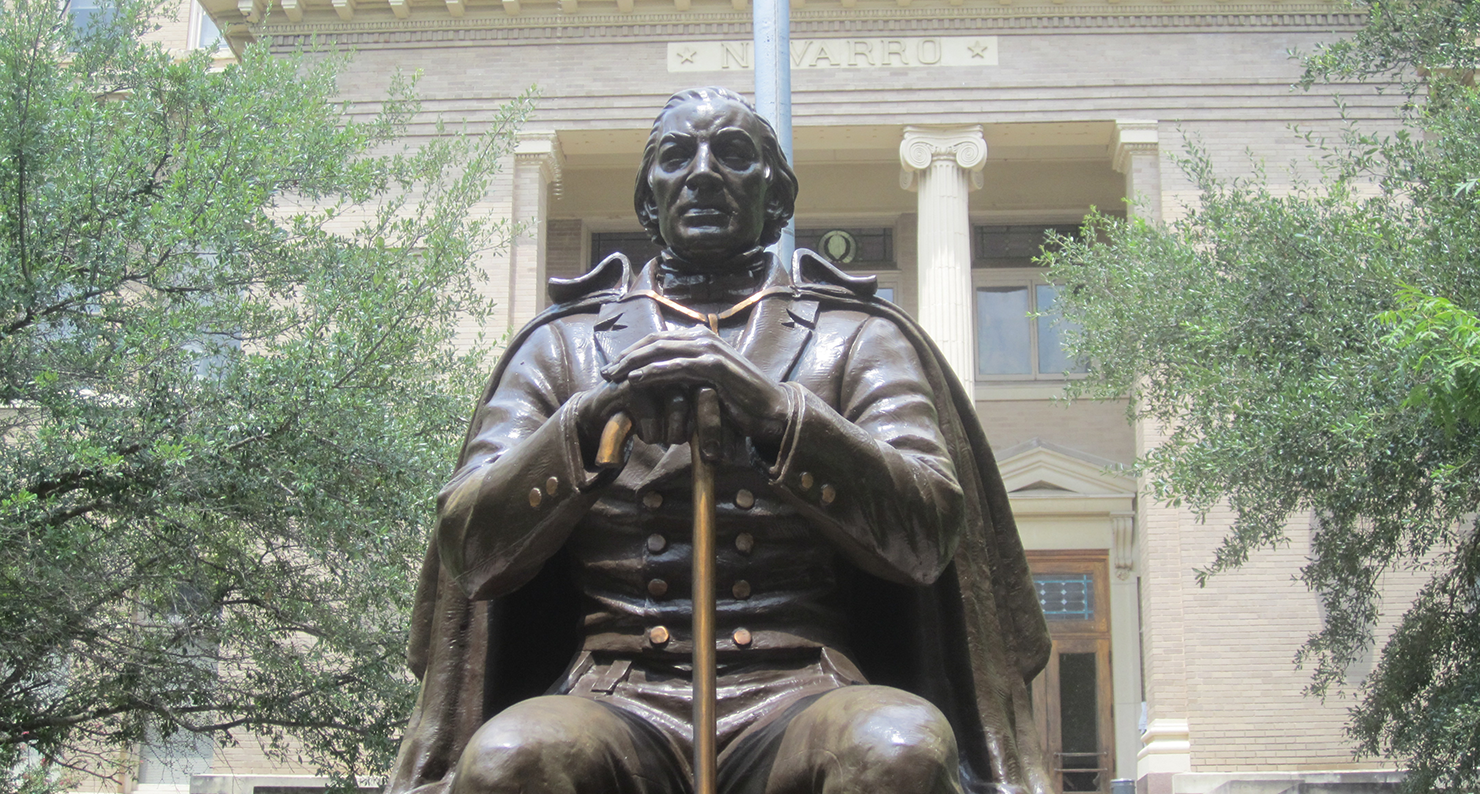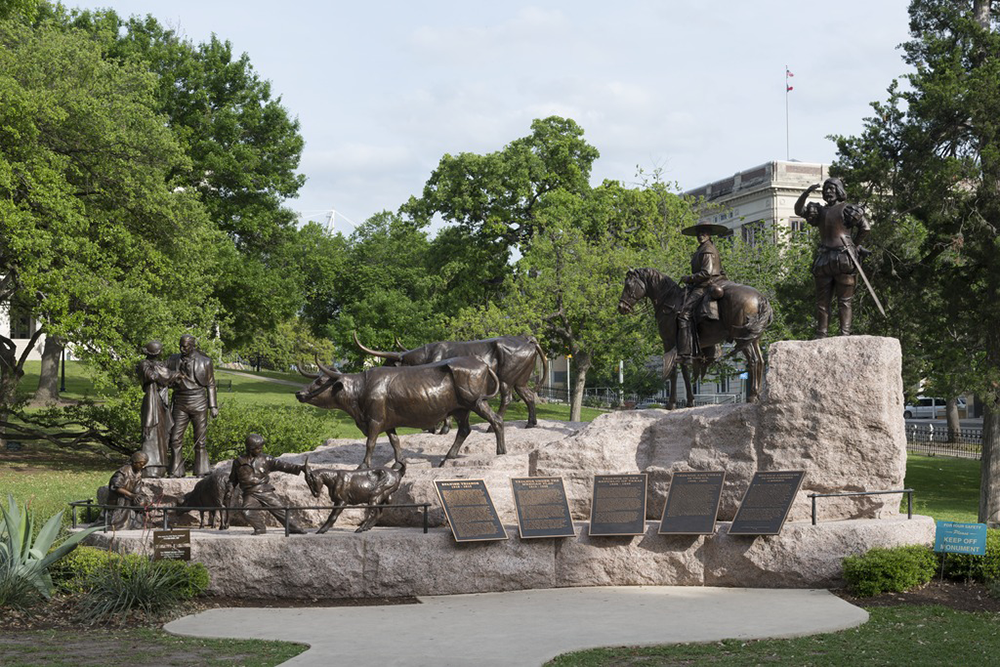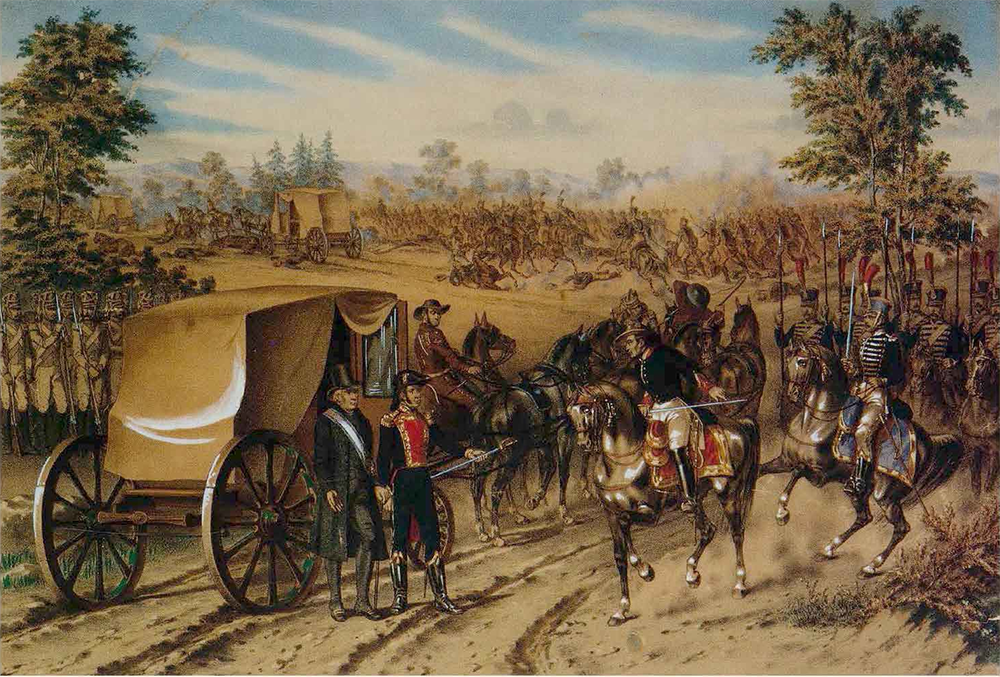
Statue of José Antonio Navarro, Navarro County Courthouse, Corsicana, Texas. Photograph by Billy Hathorn, CC BY-SA 3.0. In 1846 the newly formed county was named for Navarro, and the county seat recalls his father’s birthplace.
On March 2, 1836, while General Antonio López de Santa Anna laid siege to the Alamo mission in San Antonio, sixty men convened in the settlement of Washington-on-the-Brazos, Texas, to declare the state’s independence from the First Mexican Republic. Of those sixty, only two had been born in Texas. The historical writings of one of those two, José Antonio Navarro, are now known as the first history publications by a Tejano (Texan of Hispanic descent) author. His Commentaries of Historical Interest on San Antonio de Béxar, first published in local papers in the 1850s, were written to counter what he saw as misrepresentations of Tejanos in English-language newspapers and popular histories. His influence on both the political provenance and historical narrative of Texas features sparingly in the dominant story of the state’s founding. An inquiry into his life reveals a nuanced tale of Texan valor.
Navarro was born in San Antonio on February 27, 1795, to Ángel Navarro, a Corsican merchant who had come to the viceroyalty as a private in the Spanish army, and María Josefa Ruiz y Peña, a native of that city. When Navarro was thirteen, the death of his father forced him to leave his studies in Saltillo and return to San Antonio to work in the family store. Although his formal education stopped there, Navarro went on to become a Texas founding father as influential as any Austin, Houston, or Bowie around, although admittedly nowhere near as famous as the Anglo heroes of Lone Star lore. Indeed, those opportunity-seeking settlers (ironically the first immigrants to trailblaze what is now one of the world’s most contentious corridors for migration) wouldn’t have gained a foothold for colonization without Navarro. He was an ardent lobbyist on behalf of American settlers in the state legislature of Coahuila y Tejas. He even, at the behest of gringo compadre Stephen F. Austin, facilitated the passage of a euphemistic law that enabled Americans to continue practicing their God-given right to own “servants and hirelings” from “foreign countries.” The presence of Austin and his cohort in the state was viewed as a surefire way of bringing economy and security to a region sparsely populated by Mexicans and threatened by the violence of nomadic Native American tribes. Once political control of Texas rested in the hands of the colonizers, however, Navarro found himself on the defensive.
When Navarro signed the Texas Declaration of Independence, he reportedly “trembled at the thought of sanctioning with his signature the eternal separation of Texas from the mother country,” according to Jacob De Cordova, Texas’ first encyclopedist. Navarro had already seen the flag in the Plaza de Armas at San Antonio de Béxar change once, during Mexico’s eleven-year struggle for independence from Spain. The images of the bloodshed attendant to such an event had been, he wrote years later, “fixed into [his] retina.” So perhaps it was more than mere sentiment that caused him to shudder. Perhaps he feared history treating him as a traitor to a nascent Mexico whose independence he had supported. Or perhaps he knew he was handing over the reins of Texas history to the Anglo colonizers with their list of mostly mendacious grievances against the Mexican government.
In the ten years that Texas entertained itself playing country, Navarro found himself—one would assume unawares—defending the land rights of Tejano families from the same immigrants who had years before been welcomed into their country to defend that land from others. He unfortunately had little success in this endeavor, and after the flag was changed again to reflect U.S. statehood, many Tejano families lost land they had lived on for generations. Without his tenacious voice in the 1845 Texas Constitutional Convention, however, there was a good chance that suffrage in the state would have extended only so far as the “free white population,” and the place might have ended up a lot more like how recent textbooks want it to appear.

If Navarro’s influence in the formation of Texas isn’t given the salience it deserves in histories written by (and for) white Texans, he is remembered even less for his contributions to Texas history itself. In a series of editorials in the Western Texan in 1853 and in the San Antonio Ledger in 1857 and 1858, he aimed to defend the legacy of Tejanos from Anglo histories such as Francis Baylies’ Narrative of Major General Wool’s Campaign in Mexico, which claimed they had “sunk to the level, perhaps beneath it, of the aboriginal savages.” (For another example of xenophobic mythmaking in nineteenth-century Texas histories, see the September 15, 1853, Western Texan editorial that claimed Mexicans “do not occupy as high a position in the scale of morality and intelligence as is desirable.”) The common trope used in these histories to justify the Anglo American colonization of Texas was that centuries of bloody tyranny had reduced the Mexican people to a band of barely sentient barbarians, and the colonizers were the ones who brought justice, freedom, and true religion to the land.
The first Tejano publication to treat of Texas history was translated into English in the December 1, 1853, issue of the Western Texan. Navarro had written a direct response to a piece in the San Antonio Ledger from September of that year whose author—having drawn heavily on William Kennedy’s 1841 book, Texas: The Rise, Progress, and Prospects of the Republic of Texas—wrote that “the history of San Antonio, as well as of all Texas, is but the dreary register of petty territorial squabbles, barbarous feuds, and feats of monkish strategy.” Having witnessed firsthand some of those “petty territorial squabbles” (which only extricated Mexico from the grip of one of history’s most voracious imperialist powers), Navarro simply could not “resist the temptation to correct some substantial errors contained in that narrative.” In 1869 his articles were published in the original Spanish under the title Apuntes Históricos Interesantes de San Antonio de Béxar.
In June 1813, at the age of eighteen, Navarro had climbed the church tower at Alazán Creek, just a couple of miles west of San Antonio. There he witnessed the defeat of Colonel Ignacio Elizondo’s Spanish army at the hands of rebel José Bernardo Gutiérrez, who had gone to the U.S. to recruit American filibuster Henry Perry and others to aid the Mexican insurgency in one of that decade’s many battles for control of San Antonio. Elizondo had come for revenge after Gutiérrez and friends had brutally executed fourteen Spanish officers with razor-sharp belduques, large blades of Dutch origin popular among insurgents at the time. Although Navarro was an avid supporter of independence, his conscience forced him to speak out against such ruthlessness:
Oh, shame of the human race! Oh disgrace for the descendants of a Christian nation! What people can coolly suffer in silence an act unparalleled in the annals of the history of San Antonio de Béxar? But we owe an impartial history to posterity, that such horrible deeds may be known to the future generations so that through their own good conduct, they may eradicate such horrible stains from our benevolent soil.
The Spanish, of course, were no saints, either. Navarro goes on to tell how in August, with the help of Joaquin de Arredondo, commander-in-chief of Spanish Texas, Elizondo won back control of San Antonio for the Spanish and immediately set out toward the Trinity River in search of the fugitives of what history remembers as the Battle of Medina. In order to achieve his goal of presenting to posterity “the customs, character, abilities, and moral qualities of the men of that epoch,” Navarro includes an anecdote of the unholy alliance Elizondo used to exact his revenge. The colonel’s chaplain was a “despicable” and disgruntled priest named Padre Camacho, a cleric who had a hard time turning the other cheek. After having been wounded in the leg at the Battle of Alazán Creek, Camacho had no sympathy for rebels, and in response to pleas of mercy from fugitives caught at the Trinity, he would hike up his habit to show his battle scar and spit out the words, “Move on, my son, and suffer the penalty in the name of God, because the ball that wounded me may have come from your rifle.” Elizondo had brought the condemned men to Camacho’s confessional. When, believing the beans they spilled were just between them and the Almighty, they confessed to taking part in the insurrection, Camacho would give the Spaniards the high sign, and the fugitives were taken directly from church to the chopping block. Navarro ends his first Commentary by stating that, although Mexican independence didn’t come until eight years later, “the noble citizens of Béxar sacrificed their lives and property, performing heroic deeds of valor in the year 1813,” and “such is the beginning that brought about the independence of Texas.”

Four years later, Navarro wrote to the San Antonio Ledger to counter “a number of inexactitudes” in Henderson King Yoakum’s History of Texas from Its First Settlement in 1685 to Its Annexation to the United States in 1846, published in 1855. Although Navarro admits that “in many respects the work is appreciable and precise,” he points out a few unforgivable mistakes in the Tennessee native’s chronicle. He cites his firsthand knowledge of certain events, which precludes him from having to resort to “periphrases or allegories, as in mythological accounts.” In addition to executing a couple of characters from the story of Mexico’s independence who actually died of old age, Yoakum committed the worst possible sin against Texas: he misremembered the Alamo. Yoakum’s myths recount the story of a band of soldiers holed up inside the walls of the Alamo mission in 1785, but in that year the now unforgettable San Antonio tourist trap was called not the Alamo but the Valero mission. While the brigade called La Compañía de Álamo de Parras, from which the Valero mission would take its new name at the beginning of the nineteenth century, was hiding out in a church in a place called El Álamo in 1785, it wasn’t in Texas. It was a small town near the city of Parras de la Fuente, in the New Spanish territory of Nueva Vizcaya, now the states of Durango, Sinaloa, and Coahuila. Navarro admits that Yoakum’s errata “do not damage the substance of his history, [but] do impart an inconceivable inconsistency,” which had to be emended by “an inveterate devotee to historical materials, without literary pretensions, against all mercenary purposes,” who was definitely not in it for that history-book money, as he humblebrags in his opening paragraphs. But he was right. The specific details are not as important as the sum of their parts: if Yoakum got this much wrong, then there is a fair chance his myth of Anglo American colonizers bringing freedom, economy, and progress to a morally destitute Texas is erroneous as well.
To the modern reader who finds considerable pleasure in research that uncovers the hypocrisy and specious justifications of white colonization, Navarro the Tejano historian might come off as a chronicling saint among two-faced, double-crossing fabulists. He makes it seem that way when he avers:
I do not write for the heartless nor for the egoists—to whom the glories and misfortunes of men of another origin and language matter little or not at all. I write for the humanitarian and cultured who understand how to respect and empathize with the tribulations of a valiant people who have struggled in the midst of their own ignorance guided only by an instinct for their liberty, against enemies so superior that they may be placed alongside the most free and fortunate nations of all mankind—such as the nation with the flag of stars.
One who fails to give Navarro’s personal history the same scrutiny given the chronicles of Yoakum and his fellow yokel historians might cede him the moral high ground. Yet further investigation into Navarro’s motives for helping Austin hold on to his slaves reveals it was more than backscratching that moved him to present to the state legislature Austin’s bill to avoid Mexican antislavery laws. There is, of course, no excuse for facilitating the enslavement of another human being, but all of Navarro’s rosy language about his empathy toward those different from himself gets thrown out the window when one discovers his attitude after Mexico rid its territories of slavery. In an 1829 letter to Austin, Navarro whined about “the stupid law which the President has issued concerning the liberation of slaves!…the best men of the state are opposed to such a law. It violates justice and good faith.”
Navarro wasn’t a pious rewriter of history, but he was, without doubt, a true Texan, which is more than could be said of the mythmakers whose accounts he attempted to emend. Not only was he actually born there, he also appears to have had the proper mind-set for success in Texas: a certain cognitive dissonance that allows one to elevate the social status and quality of life of one and one’s own at the expense of an “inferior” race, and the hubris to justify such iniquity to oneself without question. Thus Navarro revealed the trope that is really at work in Texas history: the story of the bully and his mark. Behind (beneath, rather) every great Texan there tends to be a large group of darker-skinned people whose humanity has been denied them.